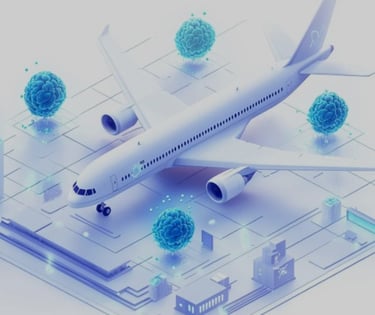
Blog
Artificial Intelligence in Ground Handling Services and Flight Operations
Artificial Intelligence in Ground Handling Services and Flight Operations: Toward a More Efficient and Intelligent Aviation Industry


1. Introduction
The aviation industry is undergoing a digital transformation, with Artificial Intelligence (AI) playing a central role in improving efficiency, safety, and customer experience. Two critical areas where AI is making a significant impact are:
- Ground Handling Services
- Flight Operations
These sectors involve complex coordination between multiple stakeholders, including airlines, airports, air traffic control, maintenance crews, and logistics providers. AI helps optimize these operations through automation, predictive analytics, real-time decision-making, and intelligent resource allocation.
2. AI in Ground Handling Services
Ground handling services include all activities that occur at an airport to prepare an aircraft for departure and receive it upon arrival. These include baggage handling, refueling, cleaning, catering, aircraft towing, passenger boarding, and more.
3. Key Applications of AI in Ground Handling:
1. Predictive Maintenance
- AI-powered systems analyze sensor data from ground equipment (e.g., baggage conveyors, fueling trucks) to predict failures before they happen.
- Reduces downtime and ensures continuous operation of critical infrastructure.
2. Automated Baggage Handling Systems
- AI algorithms manage conveyor belts and sorting machines using computer vision and RFID tracking.
- Improves accuracy and reduces lost luggage incidents.
3. Resource Allocation & Scheduling
- AI tools optimize the assignment of ground staff, vehicles, and equipment based on flight schedules, delays, and workload forecasts.
- Dynamic scheduling ensures faster turnaround times and reduced costs.
4. Real-Time Monitoring & Alert Systems
- AI monitors video feeds and IoT sensors across the apron to detect anomalies like misplaced equipment or unsafe conditions.
- Alerts are sent to supervisors for immediate action, enhancing safety and compliance.
5. Digital Twins for Airport Simulation
- AI-driven digital twins simulate ground operations under different scenarios (weather disruptions, peak hours).
- Helps planners test strategies and improve resilience.
6. Passenger Flow Management
- AI analyzes CCTV footage and mobile data to track passenger movement.
- Optimizes gate assignments, security queues, and boarding processes.
4. AI in Flight Operations
Flight operations encompass everything related to aircraft dispatch, routing, performance monitoring, and communication between pilots, dispatchers, and air traffic control.
Key Applications of AI in Flight Operations:
1. Flight Path Optimization
- AI uses weather data, wind patterns, and air traffic information to suggest optimal routes.
- Saves fuel, reduces emissions, and improves on-time performance.
2. Predictive Analytics for Delays and Disruptions
- Machine learning models predict flight delays based on historical data, weather, and current air traffic.
- Enables proactive rescheduling and crew reassignment.
3. Weather Forecasting and Avoidance
- AI integrates real-time satellite imagery and weather models to identify turbulence, storms, or icing conditions.
- Enhances flight safety and comfort by suggesting alternate routes.
4. Autonomous Taxiing and Takeoff Assistance
- AI-assisted taxiing systems guide aircraft on the ground using cameras and sensors.
- Future applications may include AI-assisted takeoffs and landings during low visibility.
5. Cockpit AI Assistants
- Voice-controlled AI assistants help pilots access checklists, manuals, and system diagnostics hands-free.
- Improves situational awareness and reduces pilot workload.
6. Fuel Efficiency Management
- AI analyzes engine performance, payload, and atmospheric conditions to recommend fuel-saving measures.
- Airlines can reduce operational costs and carbon footprint.
7. Aircraft Health Monitoring (AHM)
- AI continuously monitors aircraft systems (engines, hydraulics, avionics) during flights.
- Predicts potential faults and generates maintenance alerts before landing.
5. Challenges and Limitations
Despite its promise, AI adoption in aviation faces several challenges:
Regulatory and Compliance Issues
- Aviation is highly regulated. AI systems must meet strict certification standards (e.g., DO-178C, ARP4761).
Data Quality and Integration
- AI requires high-quality, real-time data from diverse sources — which can be difficult to collect and integrate.
Human-AI Collaboration
- Pilots, controllers, and ground staff need training to work effectively with AI tools.
Trust and Transparency
- Operators must trust AI decisions, especially in safety-critical environments.
Infrastructure Requirements
- Requires robust IT infrastructure, including cloud computing, edge devices, and secure networks.
6. Emerging Trends and Future Outlook
Collaborative AI Ecosystems
- Airlines, airports, and ATC systems sharing data via AI platforms for seamless coordination.
Generative AI in Aviation
- Use of LLMs (Large Language Models) for creating SOPs, training materials, and real-time troubleshooting guides.
AI-Powered Simulators and Training Tools
- Immersive AI-based simulators for pilot and ground crew training.
AI in Air Traffic Management (ATM)
- AI-enhanced air traffic control systems for dynamic slot allocation, conflict detection, and flow management.
Autonomous Aircraft and Drones
- AI plays a key role in managing autonomous cargo drones and future urban air mobility (UAM) vehicles.
Further Reading / Resources
- ICAO AI Strategy for Aviation
- FAA’s NextGen Air Traffic Modernization Program
- Airbus AI Lab – Research in Aviation AI
- Boeing AnalytX – AI Solutions for Airlines
- NASA’s AI for Air Traffic Control
